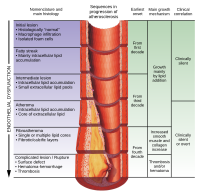
Photo from wikipedia
Objective: Atherosclerosis imaging strategies can delineate characteristics of plaques at risk of rupture and thrombosis in hypertensive patients. Structural plaque imaging identifies high-risk plaque features including lipid pools, thin fibrous… Click to show full abstract
Objective: Atherosclerosis imaging strategies can delineate characteristics of plaques at risk of rupture and thrombosis in hypertensive patients. Structural plaque imaging identifies high-risk plaque features including lipid pools, thin fibrous caps, and intraplaque hemorrhage, among others. New biochemical techniques complement structural imaging approaches such as concentration of oteopontin, osteoprotegerin, metalloproteinase 3 and sCDl40. Design and method: Study group consist of 10 patients with atherosclerotic plaque undergoing MR of the carotid arteries (or CT if contraindicated) before treatment.The concentration of plasma biomarkers of destabilization of the atherosclerotic plaque was marked using ELISA kits.The examination of the carotid arteries and IMT in the extracranial segment was performed using ultrasound with linear head with a frequency of 7.5–10 MHz..Carotid Magnetic Resonance exams was performed on the scanner with a field strength of at least 1.5 T with dedicated software to perform carotid artery and analysis of structure of atherosclerotic lesions. Statistical analysis was performed using ANOVA test, Wilcoxon or Kruskal-Wallis. Results: The mean age of patients was 58.4 years. 7 were males. Before treatment all of plaque was characterized as vulnerable. Based on the predominant components of the plaque, plaques were characterized as lipid (3), lipid with recent hemorrhage (2), fibrous (2), fibrofatty (1), fibrofatty with some hemorrhagic components (2). Moreover, we observed increase in the concentration of oteopontin, osteoprotegerin, metalloproteinase 3 and positive correlation with sCD40l. Conclusions: Based on preliminary data, it can be concluded that diagnostic Imaging methods together with biochemistry markers can provide complete information about the plaque characteristics in hypertensive patients.
Journal Title: Journal of Hypertension
Year Published: 2018
Link to full text (if available)
Share on Social Media: Sign Up to like & get
recommendations!